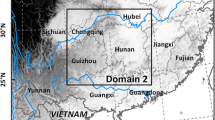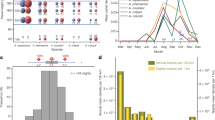Abstract
Surveys based on the density of the adult wheat midge, Sitodiplosis mosellana (Géhin) (Diptera: Cecidomyiidae), were conducted at ground level and at heights between 10 and 75 m in Xushui county (39.02 °N, 115.65 °E), Hebei province, China, in 2011. The HYSPLIT-4 model was used to analyze the possible dispersion trajectories and distances of S. mosellana depending on the experimental location. The wheat midges were trapped at altitudes from 10 to 75 m a.g.l. strongly suggest that they might also be present at much higher altitudes, where potentially, they could take advantage of the fast moving air currents. 6-h backward-trajectories indicate that adult S. mosellana could have come from both north and south, and the trajectory distances were 25–107 Km. 6-h forward-trajectories indicate that adults most likely migrated to an area located in Tianjin, Beijing and northern Hebei province, north china, and the trajectory distances were 28–195 Km. In this study, no male midges were captured at 10 m or above, which suggest male midges don’t engage in wind borne long distance migration, suggesting S. mosellana mated before dispersal. The information presented here is helpful to alter the way we view their migration over limited distances and add to our ability in outbreak forecasts.





Similar content being viewed by others
References
Berzonsky WA, Ding H, Haley SD, Lamb RJ, McKenzie RIH, Ohm HW, Patterson FL, Peairs FB, Porter DR, Ratcliffe RH, Shanower TG (2003) Breeding wheat for resistance to insects. Plant Breed Rev 22:221–296
Birkett MA, Bruce TJA, Martin JL, Smart LE, Oakley J, Wadhams LJ (2004) Responses of female orange wheatblossom midge, Sitodiplosis mosellana, to wheatpanicle volatiles. J Chem Ecol 30:1319–1328
Bryne DN (1999) Migration and dispersal by the sweet potato whitefly, Bemisia tabaci. Agric For Meteorol 97:309–316
Chapman JW, Reynolds DR, Mouritsen H, Hill JK, Riley JR, Sivell D, Smith AD, Woiwod IP (2008) Wind selection and drift compensation optimize migratory pathways in a high-flying moth. Curr Biol 18:514–518
Dalecky A, Ponsard S, Bailey RI, Pélissier C, Bourguet D (2006) Resistance evolution to Bt crops: predispersal mating of European corn borers. PLoS Biol 4:1048–1057
Dantart J, Stefanescu C, Àvila A, Alarcón M (2009) Long-distance windborne dispersal of the moth Cornifrons ulceratalis (Lepidoptera: Crambidae: Evergestinae) into the northern Mediterranean. Eur J Entomol 106:225–229
Doane JF, Olfert O (2008) Seasonal development of wheat midge, Sitodiplosis mosellana (Géhin) (Diptera: Cecidomyiidae), in Saskatchewan, Canada. Crop Prot 27:951–958
Drake VA, Farrow RA (1988) The influence of atmospheric structure and motions on insect migration. Annu Rev Entomol 33:183–210
Draxler RR, Rolph GD (2003) HYSPLIT (HYbrid Single-Particle Lagrangian Integrated Trajectory) model. NOAA ARL READY Website (http://www.arl.noaa.gov/ready/hysplit4.html). NOAA Air Resources Laboratory, Silver Spring, MD.
Elliott RH, Mann LM (1996) Susceptibility of red spring wheat, Triticum aestivum L. cv. Katepwa, during heading and anthesis to damage by wheat midge, Sitidiplosis mosellana (Géhin) (Diptera: Cecidomyiidae). Can Entomol 128:367–375
Feng HQ, Zhang YH, Wu KM, Cheng DF, Guo YY (2007) Nocturnal windborne migration of ground beetles, particularly Pseudoophonus griseus (Coleoptera: Carabidae), in China. Agr Forest Entomol 9:103–113
Gao J, Wang HJ, Wang CH (2009) Investigation and analysis on the transmission of wheat blossom midge by cross-operating of combine harvester in Hebei province. China Plant Protect 29:5–8
Gatehouse AG (1997) Behavior and ecological genetics of wind-borne migration by insects. Annu Rev Entomol 42:475–502
Jervis MA, Boggs CL, Ferns PN (2005) Egg maturation strategy and its associated trade-offs: a synthesis focusing on Lepidoptera. Ecol Entomol 30:359–375
Johnson SJ (1995) Insect migration in North America: synopticscale transport in a highly seasonal environment. In: Drake VA, Gatehouse AG (eds) Insect migration: tracking resources through space and time. Cambridge University Press, Cambridge, pp 31–66
Johnson CG (1969) Migration and dispersal of insects by flight. Methuen, London
Lorenz MW (2007) Oogenesis flight syndrome in crickets: age dependent egg production, flight performance, and biochemical composition of the flight muscles in adult female Gryllus bimaculatus. J Insect Physiol 53:819–832
McNell JN (1987) The true armyworm, Pseudoletia unipuncta: a victim of the pied piper or a seasonal migrant? Insect Sci Appl 8:591–597
Miao J, Wu YQ, Yu ZX, Chen HS, Liu ST, Jiang YL, Duan Y (2011) Trajectory analysis of long-distance dispersal of wheat midge, Sitodiplosis mosellana Géhin (Diptera: Cecidomyiidae), with air current. Acta Entomol Sin 54:432–436
Mukerji MK, Olfert O, Doane JF (1988) Development of sampling designs for egg and larval populations of the wheat midge, Sitodiplosis mosellana (Géhin) (Diptera: Cecidomyiidae), in wheat. Can Entomol 120:497–505
Ni HX, Ding HJ (1994) Dynamics and integrated management strategy of wheat midge. Bull Chin Agric Soc 10:20–23
Oakley JN (2008) Control needs for changing pest distribution. Arable cropping in a changing climate: Proceedings of the HGCA Conference. HGCA, United Kingdom, pp 87–92
Oke TR (1987) Boundary layer climates. Taylor and Francis, London
Olfert O, Elliott RH, And Hartley S (2009) Non-native insects in agriculture: strategies to manage the economic and environmental impact of wheat midge, Sitodiplosis mosellana, in Saskatchewan. Biol Invasions 11:127–133
Pedgley DE, Reynolds DR, Tatchell GM (1995) Long-range insect migration in relation to climate and weather: Africa and Europe. In: Drake VA, Gatehouse AG (eds) Insect migration: tracking resources through space and time. Cambridge University Press, Cambridge, pp 3–29
Sappington TW, Showers W (1992) Reproductive maturity, mating status, and long-duration flight behavior of Agrotis ipsilon, and the conceptual misuse of the oogenesis-flight syndrome by entomologists. Environ Entomol 21:677–688
Sedda L, Brown HE, Purse BV, Burgin L, Gloster J, Rogers DJ (2012) A new algorithm quantifies the roles of wind and midge flight activity in the bluetongue epizootic in northwest Europe. Proc R Soc B 279:2354–2362
Shen HM, Kong LP, Zhang SH, Zhang XY, Zhai BP (2011) Analysis of the source areas of the early immigration of the white-backed planthopper, Sogatella furcifera (Horváth) (Homoptera: Delphacidae), in Fujian Province. China Acta Ecol Sin 54:703–713
Wu YQ, Zhao WX, Jiang YL, Duan Y (2009) Monitoring on adults of Sitodiplosis mosellana (Gehin) with yellow sticky traps. Acta Phytophyl Sin 36:381–382
Yuan F (2004) The wheat blossom midges Sitodiplosis mosellana (Gehin) and Contarinia tritici (Kirby): their plague principle and control. Science Press, Beijing
Zhao XC, Feng HQ, Wu B, Wu XF, Liu ZF, Wu KM, McNeil JN (2009) Does the onset of sexual maturation terminate the expression of migratory behavior in moths? A study of the oriental armyworm, Mythimna separata. J Insect Physiol 55:1039–1043
Zhu M, Radcliffe EB, Ragsdale DW, MacRae IV, Seeley M (2006) Low-level jet streams associated with spring aphid migration and current season spread of potato viruses in the U.S. northern Great Plains. Agri Forest Meteo 138:192–202
Acknowledgments
The authors gratefully acknowledge the NOAA Air Resources Laboratory (ARL) for the provision of the HYSPLIT transport and dispersion model and READY website (http://www. arl.noaa.gov/ready.html) used in this publication. We thank Mr Sheng-jie Ke and Ms Ya-nan Hao, Xiao-ling Zhi, Ju Jin for assistance in field work. This work was sponsored by the China Agricultural Research System (CARS-03).
Author information
Authors and Affiliations
Corresponding author
Rights and permissions
About this article
Cite this article
Miao, J., Wu, YQ., Gong, ZJ. et al. Long-Distance Wind-Borne Dispersal of Sitodiplosis mosellana Géhin (Diptera:Cecidomyiidae) in Northern China. J Insect Behav 26, 120–129 (2013). https://doi.org/10.1007/s10905-012-9346-4
Revised:
Accepted:
Published:
Issue Date:
DOI: https://doi.org/10.1007/s10905-012-9346-4




